The Great Equalizer Part 2: Surface Pro vs. Android Devices in 3DMark
by Anand Lal Shimpi on April 2, 2013 2:26 PM EST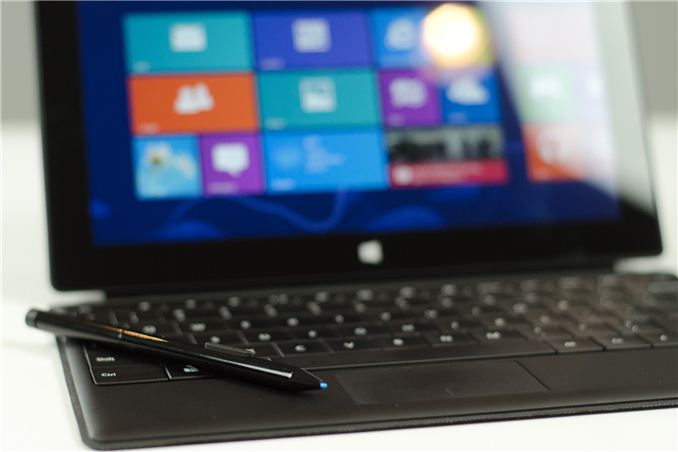
While we're still waiting for Windows RT and iOS versions of the latest 3DMark, there is one cross-platform comparison we can make: Ivy Bridge/Clover Trail to the Android devices we just tested in 3DMark.
The same caveats exist under 3DMark that we mentioned in our GL/DXBenchmark coverage: not only is this a cross-OS comparison, but we're also looking across APIs as well (OpenGL ES 2.0 for Android vs. Direct3D FL 9_1 for Windows). There will be differences in driver maturity not to mention just how well optimized each OS is for the hardware its running on. There are literally decades of experience in optimizing x86 hardware for Windows, compared to the past few years of evolution on the Android side of the fence.
Absent from these charts is anything running on iOS. We're still waiting for a version of 3DMark for iOS unfortunately. If our previous results are any indication however, Qualcomm's Adreno 320 seems to be hot on the heels of the GPU performance of the 4th generation iPad:
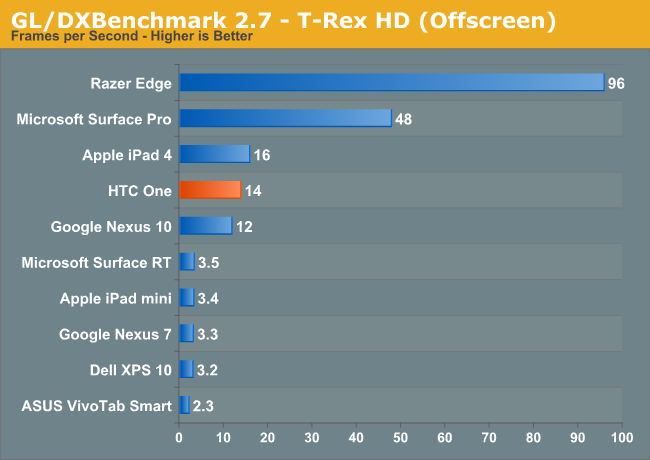
In our GL/DXBenchmark comparison we noted Microsoft's Surface Pro (Intel HD 4000 graphics) managed to deliver 3x the performance of the 4th generation iPad. Will 3DMark agree?
All of these tests are run at the default 720p settings. The key comparisons to focus on are Surface Pro (Intel HD 4000), VivoTab Smart (Intel Clover Trail/SGX 545) and the HTC One (Snapdragon 600/Adreno 330). I've borrowed the test descriptions from this morning's article.
Graphics Test 1
Ice Storm Graphics test 1 stresses the hardware’s ability to process lots of vertices while keeping the pixel load relatively light. Hardware on this level may have dedicated capacity for separate vertex and pixel processing. Stressing both capacities individually reveals the hardware’s limitations in both aspects.
In an average frame, 530,000 vertices are processed leading to 180,000 triangles rasterized either to the shadow map or to the screen. At the same time, 4.7 million pixels are processed per frame.
Pixel load is kept low by excluding expensive post processing steps, and by not rendering particle effects.
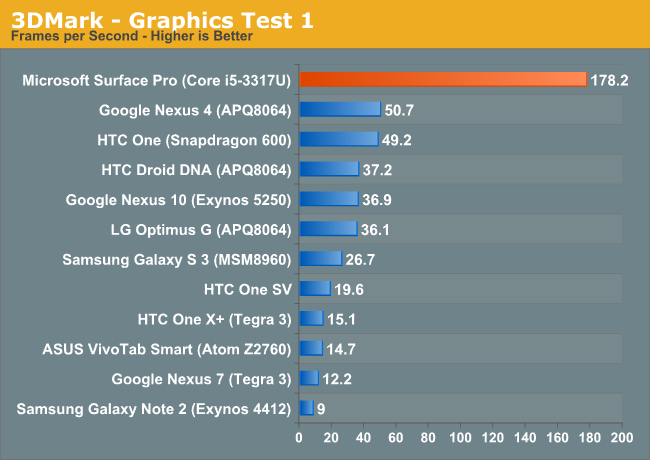
In this mostly geometry bound test, Surface Pro does extremely well. As we saw in our GL/DXBenchmark comparison however, the ARM based Android platforms don't seem to deliver the most competitive triangle throughput.
Graphics Test 2
Graphics test 2 stresses the hardware’s ability to process lots of pixels. It tests the ability to read textures, do per pixel computations and write to render targets.
On average, 12.6 million pixels are processed per frame. The additional pixel processing compared to Graphics test 1 comes from including particles and post processing effects such as bloom, streaks and motion blur.
In each frame, an average 75,000 vertices are processed. This number is considerably lower than in Graphics test 1 because shadows are not drawn and the processed geometry has a lower number of polygons.
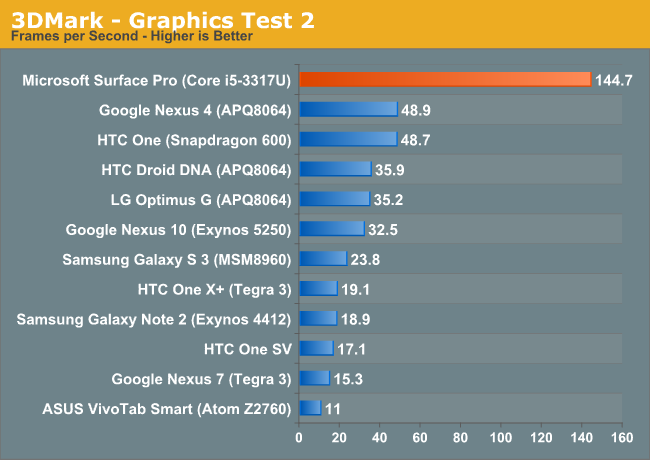
The more pixel shader bound test seems to agree with what we've seen already: Intel's HD 4000 appears to deliver around 3x the performance of the fastest ultra mobile GPUs, obviously at higher power consumption. In the PC space a 3x gap would seem huge, but taking power consumption into account it doesn't seem all that big of a gap here.
Physics Test
The purpose of the Physics test is to benchmark the hardware’s ability to do gameplay physics simulations on CPU. The GPU load is kept as low as possible to ensure that only the CPU’s capabilities are stressed.
The test has four simulated worlds. Each world has two soft bodies and two rigid bodies colliding with each other. One thread per available logical CPU core is used to run simulations. All physics are computed on the CPU with soft body vertex data updated to the GPU each frame. The background is drawn as a static image for the least possible GPU load.
The Physics test uses the Bullet Open Source Physics Library.
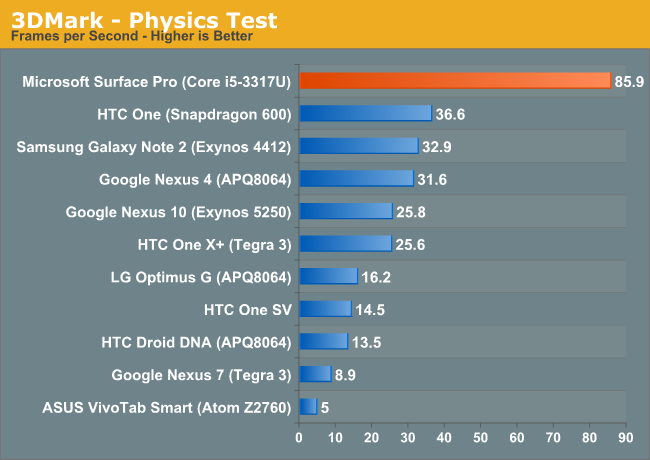
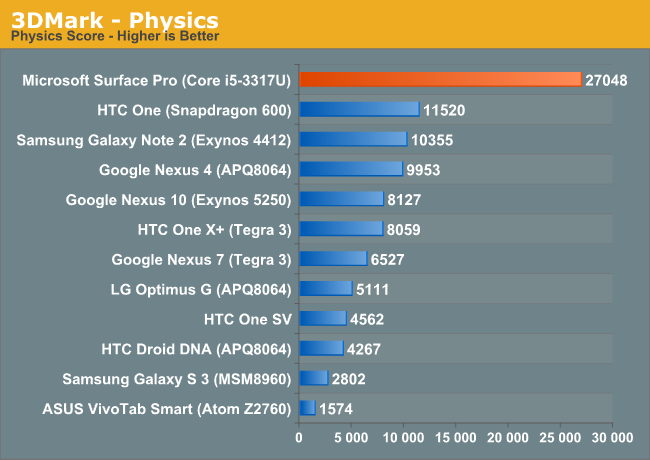
Surprisingly enough, the CPU bound physics test has Surface Pro delivering 2.3x the performance of the Snapdragon 600 based HTC One. Quad-core Cortex A15 based SoCs will likely eat into this gap considerably. What will be most interesting is to see how the ARM and x86 platforms converge when they are faced with similar power/thermal constraints.
What was particularly surprising to me is just how poorly Intel's Atom Z2560 (Clover Trail) does in this test. Granted the physics benchmark is very thread heavy, but the fact that four Cortex A9s can handily outperform two 32nm Atom cores is pretty impressive. Intel hopes to fix this with its first out-of-order Atom later this year, but that chip will also have to contend with Cortex A15 based competitors.
Ice Storm - Overall Score
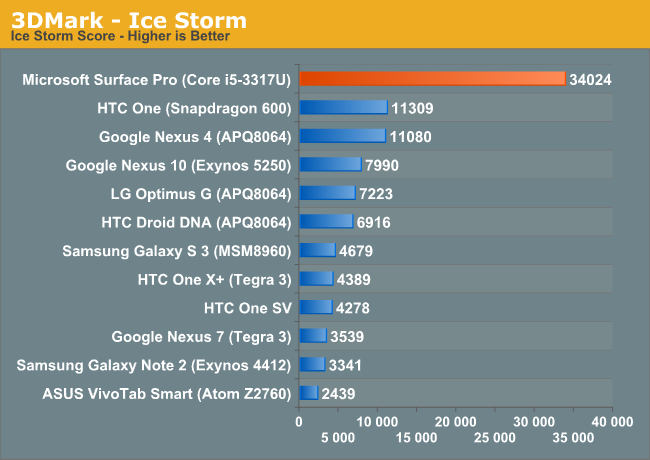
The overall score seems to agree with what we learned from the GL/DXBenchmark comparison. Intel's HD 4000 delivers around 3x the graphics performance of the leading ultra mobile GPUs, while consuming far more power. Haswell will drive platform power down, but active power should still be appreciably higher than the ARM based competition. I've heard rumblings of sub-10W TDP (not SDP) Haswell parts, so we may see Intel move down the power curve a bit more aggressively than I've been expecting publicly. The move to 14nm, and particularly the shift to Skylake in 2015 will bring about true convergence between the Ultrabook and 10-inch tablet markets. Long term I wonder if the 10-inch tablet market won't go away completely, morphing into a hybird market (think Surface Pro-style devices) with 7 - 8 inch tablets taking over.
It's almost not worth it to talk about Clover Trail here. The platform is just bad when it comes to graphics performance. You'll notice I used ASUS' VivoTab Smart here and in the GL/DXBenchmark comparison instead of Acer's W510. That's not just because of preference. I couldn't get the W510 to reliably complete GL/DXBenchmark without its graphics driver crashing. It's very obvious to me that Intel didn't spend a lot of time focusing on 3D performance or driver stability with Clover Trail. It's disappointing that even in 2012/2013 there are parts of Intel that still don't take GPU performance seriously.
The next-generation 22nm Intel Atom SoC will integrate Intel's gen graphics core (same architecture as HD 4000, but with fewer EUs). The move to Intel's own graphics core should significantly modernize Atom performance. The real question is how power efficient it will be compared to the best from Imagination Tech and Qualcomm.


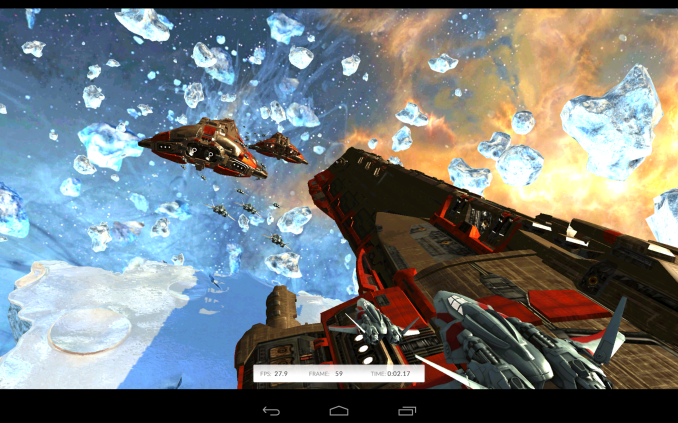










56 Comments
View All Comments
xanxavier - Tuesday, April 2, 2013 - link
Any chance you can divide the average power used per test into the scores to give us a performance factored by power ratio? That would be interesting to see. I think it was kind of obvious the hd4000 would win, but what if the lower end graphics had a higher TDP....3DoubleD - Tuesday, April 2, 2013 - link
+1I was thinking the exact same thing. It would be very interesting to see that ratio.
dou che - Thursday, April 4, 2013 - link
why? ipad just sucks, admit it.Sabresiberian - Sunday, April 7, 2013 - link
Well, frankly the user interested in a Surface Pro right now isn't all that concerned about power/performance ratio, they are interested in running a full-blown OS on a high-quality piece of hardware.Not that what you are asking for isn't important or interesting, it certainly is and would be. However, I will be more interested in those numbers when the Surface comes out using Haswell; I think Haswell will be a game-changer for it. The only reason MS released it now (using Ivy Bridge) was because they wanted to get it on the market and in the minds of potential buyers as soon as possible. In my opinion, of course.
r3loaded - Tuesday, April 2, 2013 - link
Clover Trail's showing is frankly pathetic, especially when it's being beaten by a $200 Nexus 7. Then again, I didn't expect much since they stuck with an SGX545 instead of anything remotely modern for the GPU. If I didn't know it was simply a stopgap for Bay Trail, I'd have completely dismissed them from the running altogether.powerarmour - Tuesday, April 2, 2013 - link
It's mainly the drivers that are pathetic, as weak as the SGX545 is, Intel have done it no favours under DirectXAlexvrb - Wednesday, April 3, 2013 - link
It's both. In raw shader performance at equal clocks, the 545 has 1/8th the punch of an SGX554MP4. Intel has attempted to make up for lost ground a bit by cranking up the clockspeed, but they really should have used at least an SGX544MP2 at a bare minimum. Then on top of that, as you implied, the drivers are complete and total crap. Intel drivers have a history of being bad, but they've really taken it to the extreme here.rwei - Wednesday, April 3, 2013 - link
Sure, but that's to be expected. Why invest more than needed in a stopgap platform that you will soon abandon, to benefit only a fraction of your user base?I'd rather see them focus their resources on continuing to build the HD 4000 line.
Alexvrb - Wednesday, April 3, 2013 - link
Except they didn't even design the graphics chip in this "stopgap platform". The company that did (Imagination Technologies) had better designs when Intel made this chip, but Intel went ahead with the very outdated SGX545. Again, ImagTech had better solutions on the table, and other companies were using them.Intel just didn't care enough, they saved on transistors and made a bigger profit. If you bought one, sucks to be you. Oh wait, isn't that Atom in a nutshell since it was introduced? Every generation someone says me that the next Atom will be worth a damn... I'm still waiting.
Lodorand - Friday, April 5, 2013 - link
What's baffling is how strongly Intel is itching to penetrate the mobile market, yet it refuses (or fails) to put more resources into the Atom line and prefers to use outdated technologies and architectures. Well you can't have it both ways, Intel, you either invest or accept your irrelevancy.